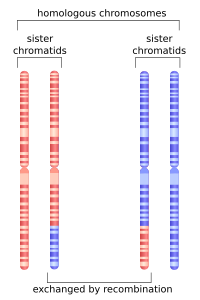
Photo from wikipedia
The genetic recombination process mediated by crossing over (CO) events is not random along chromosomes and its occurrence can drive molecular evolution and genome organization. In this study, a position-recoding… Click to show full abstract
The genetic recombination process mediated by crossing over (CO) events is not random along chromosomes and its occurrence can drive molecular evolution and genome organization. In this study, a position-recoding algorithm was developed to convert cytological CO detected in tomato (Solanum lycopersicum) chromosomes into physical genome coordinates. The meiotic recombination profile displays a punctual distribution of the crossover frequency along the chromosomes, which may be used to conduct further analysis. The recombination profile is not uniform and follows the same distribution profile as the coding sequences. On analyzing the positions of resistance (R) genes we found that most nucleotide-binding domain-leucine-rich repeat (NB-LRR) loci accumulate in hot recombination regions of the distal subtelomeric regions, while few NB-LRR loci tend to reside in proximal cold recombination regions. As the local meiotic crossover frequency is known to make an important contribution to the molecular evolution rate of a genome region, this divergent drift of the resistance loci toward hot and cold recombination areas may reflect different evolution needs for the species with respect to plant-pathogen co-evolution. The generation of novel haplotypes, promoted by recombination reshuffling, is more favorable for R loci that require rapid diversification to overcome the emergence of new pathogen races. Instead, cold areas may be more advantageous for maintaining R genes that confer durable resistance over time. Knowledge of chromosome region recombination rates and R-gene distribution may be useful to steer future disease resistance breeding schemes and select favorable allele combinations.
Journal Title: Euphytica
Year Published: 2017
Link to full text (if available)
Share on Social Media: Sign Up to like & get
recommendations!